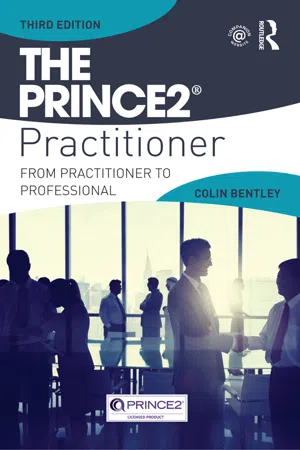
- 302 pages
- English
- ePUB (mobile friendly)
- Available on iOS & Android
About this book
Struggling to apply the principles of PRINCE2 in practice?
Need guidance on adapting the process for smaller projects?
PRINCE2 for Practitioners provides the solution. This practical reference, matching the details and requirements of the 2009 PRINCE2 manual, contains new and updated real-life examples and case studies, links between related components and processes, and clear guidance on how to fine-tune the method to help you manage projects successfully, whatever the context and size.
An affordable alternative to expensive training, this best-selling handbook by PRINCE2 expert Colin Bentley is an indispensable addition to your project management bookshelf and a companion to the PRINCE2 for Beginners book. If you have passed the PRINCE2 exams, it will help you keep your knowledge and skills up to date to maintain registered status and enable you to apply the theory of PRINCE2 to everyday project work after certification.
Frequently asked questions
- Essential is ideal for learners and professionals who enjoy exploring a wide range of subjects. Access the Essential Library with 800,000+ trusted titles and best-sellers across business, personal growth, and the humanities. Includes unlimited reading time and Standard Read Aloud voice.
- Complete: Perfect for advanced learners and researchers needing full, unrestricted access. Unlock 1.4M+ books across hundreds of subjects, including academic and specialized titles. The Complete Plan also includes advanced features like Premium Read Aloud and Research Assistant.
Please note we cannot support devices running on iOS 13 and Android 7 or earlier. Learn more about using the app.
Information
Chapter 1
Introduction
Chapter 2
An Overview of PRINCE2
2.1 Project Performance Aspects
- Costs: Estimating how much a project will cost is always a problem, followed by controlling efficiency and effectiveness to ensure that this cost is not exceeded.
- Time: How long will the project take? How effective will resources be? Have you made allowances for meetings, training, holidays, learning cycles?
- Quality: More important than getting cost and time right is getting the quality right. Do you know what quality the customer wants? Is that level of quality realistic in view of other constraints, such as time and cost? Have you allowed enough time and resources to achieve that quality?
- Scope: How precisely are the requirements known? Have you got an agreed cut-off point for finalizing requirements? Have you got a change control procedure in place to avoid ‘scope creep’? Does the customer understand that, after you have agreed a price and time frame, any changes to the specification must be paid for? If the customer’s detailed knowledge of the requirements is going to evolve slowly, is the cost and time needed to provide the changing requirements also allowed to ‘evolve’?
- Risk: Have you reviewed the project for risks at the outset? Are you regularly reviewing risks? Do you have a risk management procedure in place? Do you know what level of risk the customer is willing to accept?
- Benefits: Are there valid reasons for doing the project? Does the outcome fit with company strategy? Are the claimed benefits realistic? Do you have measurements of the situation now, before the outcome is delivered, in order to measure the achievement of benefits?
2.2 Principles Of PRINCE2
- Universal: They apply to every project, any type, any size.
- Self-validating: They have been proved by use over many years.
- Empowering: They give users of the method the ability to shape the management of the project.

- Continued business justification;
- Learn from experience;
- Defined roles and responsibilities;
- Manage by stages;
- Manage by exception;
- Focus on products;
- Tailor to suit the project environment.
2.2.1 Continued business justification
- You shouldn’t start a project unless there is a sound Business Case for it.
- Make sure that the potential benefits are realistic and measurements of the current situation have been documented.
- At regular intervals in the project you should check that the project is still viable.
- Stop the project if the justification has disappeared.
- Should be documented and approved;
- Drives the decision-making processes;
- Ensures that the project remains aligned to the business objectives and benefits being sought.
2.2.2 Learn from experience
2.2.3 Defined roles and responsibilities
- Business;
- User;
- Supplier.

2.2.4 Manage by stages
- 1) If the Project Board is, in PRINCE2 terms, ultimately accountable for the project, and as PRINCE2 doesn’t like the idea of regular progress meetings, there must be some key points in a project when the Project Board needs to review progress and decide if it wants to continue with the project – i.e. that the project is still viable;
- 2) Very often a project will last longer and contain more detail than can be planned for with any accuracy at the outset.
2.2.5 Manage by exception
Table of contents
- Cover
- Title
- Copyright
- Contents
- List of figures
- Preface
- 1 Introduction
- 2 An Overview of PRINCE2
- 3 Business Case
- 4 Organization
- 5 Plans
- 6 Progress
- 7 Quality
- 8 Risk
- 9 Change
- 10 Starting up a Project (SU)
- 11 Initiating a Project (IP)
- 12 Directing a Project (DP)
- 13 Controlling a Stage (CS)
- 14 Managing Product Delivery (MP)
- 15 Managing a Stage Boundary (SB)
- 16 Closing a Project (CP)
- 17 Tailoring PRINCE2 to the Project Environment
- Appendix A Product Descriptions
- Appendix B Project Management Team Roles
- Appendix C Product-based Planning
- Appendix D Quality Review
- Appendix E Risk Categories
- Index